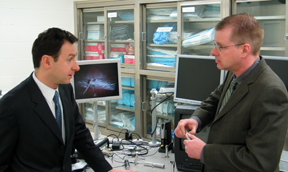 |
Dmitry Oleynikov, M.D., left, and Shane Farritor, Ph.D., discuss the surgical robots. |
The tiny robots from Nebraska were co-designed by Dmitry Oleynikov, M.D., director of minimally invasive surgery at UNMC, and Shane Farritor, Ph.D., associate professor of mechanical engineering at the University of Nebraska-Lincoln. During live videoconferences, Dr. Oleynikov will guide the undersea astronauts, or aquanauts, in how to manipulate and position the mini-robots to help perform surgery.
“These robots, with suggestions from doctors on earth, would allow astronauts to perform a number of different emergency surgeries in space,” Dr. Oleynikov said.
As NASA sends more astronauts to explore Mars and the moon, surgical needs could arise during expeditions. This is NASA’s ninth underwater NEEMO mission. NEEMO stands for NASA Extreme Environment Mission Operations. The underwater habitat, called Aquarius, is 63 feet below sea level and models the isolated environment in which astronauts work. The procedures simulated in Aquarius may one day be used to respond to emergencies on the International Space Station, the moon or Mars.
“We want to demonstrate that robots are useful in these situations,” said Dr. Farritor, who trained the NEEMO 9 crew to use the mini-robots. Farritor, research assistant professor Steve Platt and graduate students Mark Rentschler, Jason Dumpert, Kyle Berg and Amy Lehman are collecting data for the mission. Farritor said UNL researchers would study how long each procedure took and whether scientists performed tasks efficiently. The information may help them improve the robots or training methods.
Because the mini-robots are capable of being controlled through wireless communication, Platt said they have potential for use in other remote locations, such as battlefields or rural areas.
“The ability to bring surgical capabilities to areas that are not accessible holds great promise for this technology,” Platt said.
One of the tasks assigned to NEEMO’s aquanauts is to use the mini-robots to help perform a laparoscopic appendectomy on a human simulator. The benefit of performing surgery laparoscopically is it requires very small incisions and generally leads to a much quicker surgical recovery.
During the simulated appendectomy, Dr. Oleynikov will tele-mentor the aquanauts to insert the lipstick tube-sized robots into the “pretend patient” through laparoscopic tubes. One of the robots has a camera that tilts and pans. The other robot is also fitted with a camera, but is mobile and can be directed to move within the abdominal cavity. Both give the surgeon much better views of the abdomen than traditional laparoscopic cameras, which have very little mobility.
Other mini-robots under development at the University of Nebraska include a mobile unit with a grasping tool that could be used to biopsy a piece of tissue, and a robot small enough to be swallowed.
The mini-robots have been the subject of numerous news stories and gained a lot of attention since UNMC and UNL began working on them two years ago. The researchers continue to explore new designs and uses for the robots.
As evidenced by the NEEMO mission, the goal is for doctors to someday use these robots to perform surgery off-location.
“Getting expertise in foreign environments is very useful, and I think these robots have a lot of potential in space and on Earth,” Dr. Farritor said.
In addition to the experiments with the mini-robots, Dr. Mehran Anvari, NEEMO 9 chief scientific officer and director of the Centre for Minimal Access Surgery (CMAS) at McMaster University in Hamilton, Ontario, Canada, has performed telerobotic surgery experiments using a different robot developed by a US-based group. Dr. Anvari successfully used a new, portable prototype system to stitch a simulated patient aboard the undersea laboratory Aquarius off Key Largo, Fla.
The NEEMO 9 mission is a joint project of McMaster University’s CMAS at St. Joseph’s Healthcare, the U.S. Army Telemedicine and Advanced Technology Research Center, the National Space Biomedical Research Institute, NASA, and the Canadian Space Agency.
The mission builds on the success of the NEEMO 7 mission in October 2004 and will continue to evaluate new medical diagnostic and therapeutic technologies to enhance the delivery of state-of-the-art medical care in remote and harsh environments, as well as develop procedures and techniques for lunar exploration using remotely operated vehicles, tracking systems and navigation devices. A prototype next generation surgical robot will be evaluated with surgeons in Hamilton, Canada, attempting remote surgical procedures using the robot and a patient simulator in the Aquarius Undersea Habitat.